|
Reichsrevolver C79/83 |
|
|
|
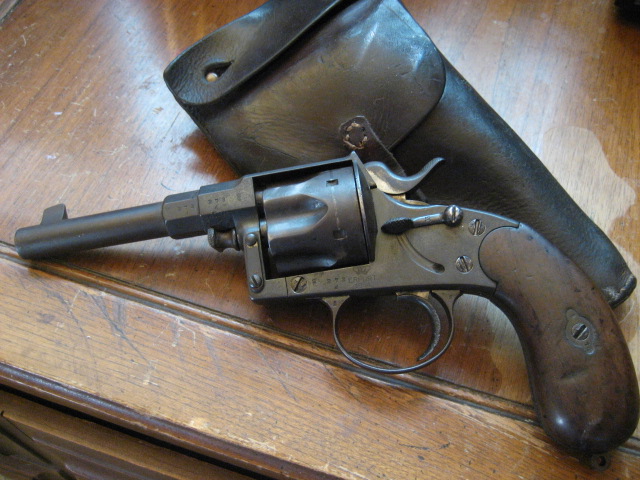
1883 Reichsrevolver
used by the East Asian Artillery
Photo © Dow Cross |
|
The 1879 Reichsrevolver was
introduced for officers and mounted
troops in the Prussian army from 1879 onwards. In 1883 a
modified version was introduced with a shorter barrel. They
remained in use up until and during the First World War despite
being officially replaced from 1908 onwards by the Luger P08. The
1879 and 1883 revolvers both fired six 10.6mm rounds from a revolving magazine.
Both models (in issue and privately purchased versions) were commonly used by the Schutztruppe and other
overseas troops from the 1880s onwards. The
photograph on the left shows an 1883
Reichsrevolver with two sets of unit markings. The first is "OA1
MK1" for "Ostasiatisches Field-Artillerie Regiment Batterie 1
Muntionskolonne 1." (East Asian Artillery Regiment, 1st Battery,
1st Munitions Supply Column). The second marking after it is a
later issue marking "143R.9.5.." for the 9th Company of the
143rd Lower Alsatian Infantry Regiment ("4. Unter-Elsässisches
Infanterie-Regiment. Nr.143") which served on the Western Front
during the First World War. For more photos of this
pistol see East Asian
Reichsrevolver Page.
|
| |
|
|
|
Luger Parabellum |
|
|
|
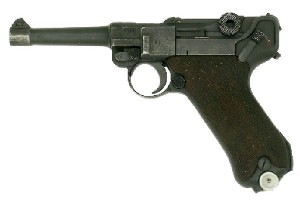
Luger Parabellum 08
used by the Imperial Navy
Photo from
WikiCommons /
Adams
Guns |
|
The Parabellum was a
semi automatic 9mm pistol
designed by Austrian, Georg Luger. Several variants were
made over the years. The Imperial navy first adopted the Luger
in 1904 as the Pistole 04 with a 15cm barrel. It was
used by Marine Infantry in East Africa in 1906 but was found to
be unhelpful in that its safety mechanism did not allow for
quick use in action, therefore some officers and NCOs preferred
to purchase Brownings or other weapons.
In 1908 a modified version with
shorter 10cm barrel was adopted by the German army and remained
in service through both world wars as the Pistole 08.
The photograph on the left shows a Pistole
08 made in 1917 and issued to the Imperial Navy as is shown by a
crowned M marking on the left chamber. It has been re-issued and
rebuilt since then, in 1920 and possibly in East Germany after
the Second World War.
|
| |
|
|
|
Mauser C96 |
|
|
|
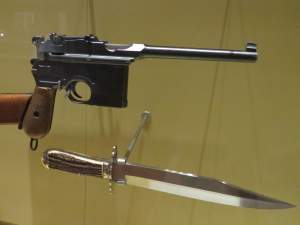
Mauser C96 and a Bowie Knife
used by a German
officer in New Guinea
Photo by Sebastien
Grenda at the Australian War Memorial, Canberra |
|
The Mauser C96 (nicknamed
the Broom Handle) was a semi-automatic pistol designed by
Fidel, Friedrich, and Josef Feederle and manufactured by
Mauser from 1896 onwards. It was designed to be able
to receive a wooden stock attachment if needed, which also doubled as
its holster.
It was a popular choice of
pistol as a private purchase option for officers in the
Imperial German army and navy of the early 20th Century. The
C96 was also in use in other armies including those
of Italy, Austria, Finland and China. Winston Churchill carried
a C96 at the Battle of Omdurman during the Sudan Campaign of 1898. The C96 finally ceased production in 1937.
The pistol in the photo on the
left was captured from a German officer by Australian forces in New
Guinea, 1914. It is now on display at the Australian War Memorial,
Canberra.
For more photos of the C96, see
C96 in South West
Africa
|
| |
|
|
|
Roth-Sauer |
|
|
|
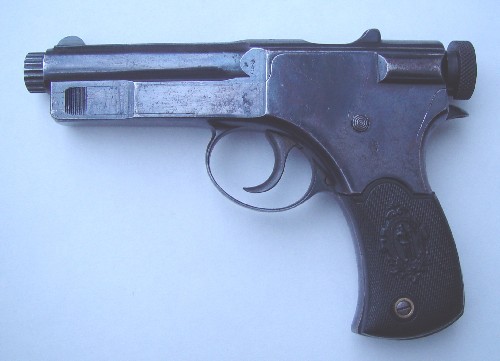
Roth-Sauer
used
by the Landespolizei of South West
Africa
Photo © Alistair Hayes |
|
The Roth-Sauer Pistol was designed and
patented in 1900 by an Austrian and a Hungarian, Georg Roth and
Karel Krnka. It was manufactured by JP Sauer & Sohn in Suhl, and
Sauer bought the patent in 1910. The pistol itself was a 7.65mm,
automatic with a seven round magazine. It had a recoiling barrel
and a unique cocking system which also worked as a safety catch.
The pistol did not prove popular and it was not widely issued to
either the Austro-Hungarian or German armies.
It was however used by the Landespolizei of South West Africa. According to
"Unter
dem Kreuz des Südens" by S Schepp there were 213 Roth-Sauer pistols in
service with the Landespolizei in 1912.
The pistol shown
on the left has the Landespolizei marking and weapon number "L.P.92" on the
back of the grip. For more photos of this
pistol see
Landespolizei Pistol Page. |
| |
|
|
|
Mauser C10 |
|
|
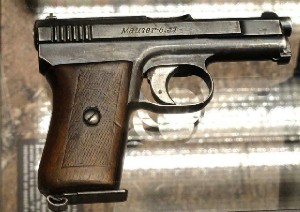
Mauser 1910
Photo from
WikiCommons /
National World War I Museum, Kansas City |
|
The Mauser 1910
semi-automatic pistol was a popular privately purchased weapon used by
the officers of the Imperial German army before and during the First
World War.
It is highly likely that it was also
purchased by officers of the Schutztruppe, Pascha Expeditions and other
overseas troops.
|
| |
|
|
|
Browning FN1900 |
|
|
|

Browning FN1900
used by
a
South West African Schutztruppe officer.
Here the pistol is
displayed with a Colonial Veterans Elephant Order
Photo from
WikiCommons /
Adams
Guns |
|
In 1896, American John
Browning designed a
semi-automatic pistol which was produced from 1900 by
Fabrique Nationale de Herstal in Belgium. It was the first
production handgun to use a
slide, later common on semi-automatic pistols.
It became a popular choice of privately
purchased pistol by German officers and those of other nationalities.
Future
US
Theodore Roosevelt owned a Browning FN1900, which he regularly
kept on his person and in his bedside drawer.
The pistol in the photo on the
left was used by
Leutnant von Barsewisch
of the South West African Schutztruppe during the Herero
Rebellion (See
Adams Guns for more photos and the full story). |